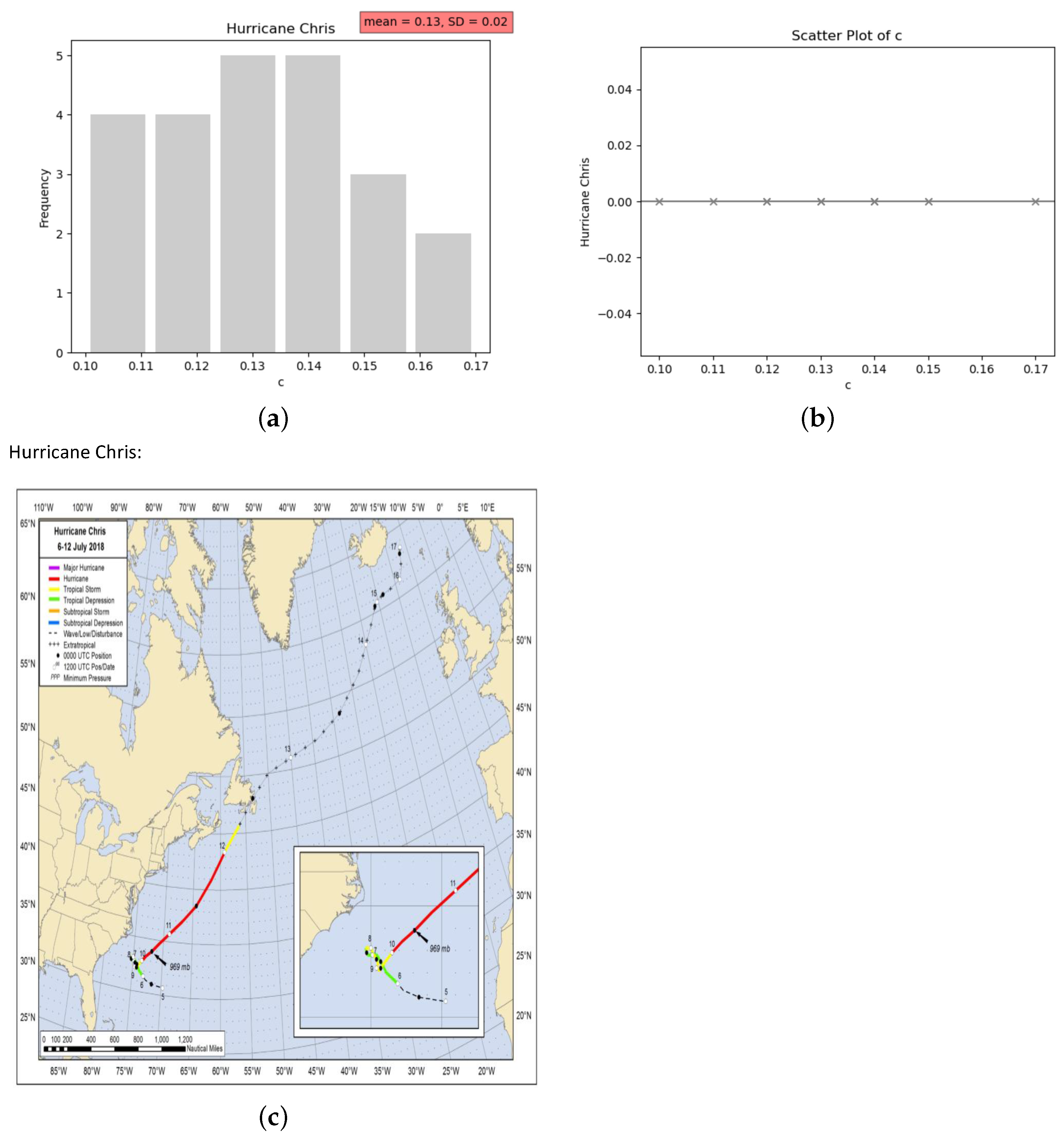On the Relation between Wind Speed and Maximum or Mean Water Wave Height
Abstract
:1. Introduction
2. Methods
2.1. General Dimension Analysis
2.2. Inviscid Two-Fluid Model
2.2.1. Traveling Waves
2.2.2. Potential Flows
3. Results and Discussion
3.1. Verification of the Wave Height–Wind Speed Relation
3.2. Wind Speed Relation in Comparison to Model Runs
4. Conclusions
Author Contributions
Funding
Institutional Review Board Statement
Informed Consent Statement
Data Availability Statement
Conflicts of Interest
References
- Park, G. A comprehensive analysis of hurricane damage across the US gulf and atlantic coasts using geospatial big data. ISPRS Int. J. Geo-Inf. 2021, 10, 781. [Google Scholar] [CrossRef]
- Lin, N.; Emanuel, K.A.; Smith, J.A.; Vanmarcke, E. Risk assessment of hurricane storm surge for New York City. J. Geophys. Res. Atmos. 2010, 115, D18121. [Google Scholar] [CrossRef]
- Lin, N.; Emanuel, K.; Oppenheimer, M.; Vanmarcke, E. Physically based assessment of hurricane surge threat under climate change. Nat. Clim. Chang. 2012, 2, 462–467. [Google Scholar] [CrossRef]
- Knauss, J.A.; Garfield, N. Introduction to Physical Oceanography; Waveland Press: Long Grove, IL, USA, 2017. [Google Scholar]
- National Data Buoy Center; National Oceanic and Atmospheric Administration. National Data Buoy Center. 2024. Available online: https://www.ndbc.noaa.gov/ (accessed on 20 January 2020).
- Katalinić, M.; Ćorak, M.; Parunov, J. Analysis of wave heights and wind speeds in the Adriatic Sea. Marit. Technol. Eng. 2014, 1, 1389–1394. [Google Scholar]
- Kumar, V.S.; Mandal, S.; Kumar, K.A. Estimation of wind speed and wave height during cyclones. Ocean. Eng. 2003, 30, 2239–2253. [Google Scholar] [CrossRef]
- Phadke, A.C.; Martino, C.D.; Cheung, K.F.; Houston, S.H. Modeling of tropical cyclone winds and waves for emergency management. Ocean. Eng. 2003, 30, 553–578. [Google Scholar] [CrossRef]
- Drazin, P.G.; Reid, W.H. Hydrodynamic Stability, 2nd ed.; Cambridge Mathematical Library, Cambridge University Press: Cambridge, UK, 2004; pp. xx+605. [Google Scholar] [CrossRef]
- Miles, J.W. On the generation of surface waves by shear flows. J. Fluid Mech. 1957, 3, 185–204. [Google Scholar] [CrossRef]
- Miles, J.W. On the generation of surface waves by shear flows. II. J. Fluid Mech. 1959, 6, 568–582. [Google Scholar] [CrossRef]
- Miles, J.W. On the generation of surface waves by shear flows. III. Kelvin-Helmholtz instability. J. Fluid Mech. 1959, 6, 583–598. [Google Scholar] [CrossRef]
- Janssen, P. The Interaction of Ocean Waves and Wind; Cambridge University Press: Cambridge, UK, 2004. [Google Scholar]
- Lokharu, E.; Wahlén, E.; Weber, J. On the amplitude of steady water waves with favorable constant vorticity. J. Math. Fluid Mech. 2023, 25, 7. [Google Scholar] [CrossRef]
- Lokharu, E. A sharp version of the Benjamin and Lighthill conjecture for steady waves with vorticity. arXiv 2020, arXiv:2011.14605. [Google Scholar] [CrossRef]
- Benjamin, T.B.; Lighthill, M.J. On cnoidal waves and bores. Proc. R. Soc. Lond. Ser. Math. Phys. Sci. 1954, 224, 448–460. [Google Scholar]
- Benjamin, T.B. Verification of the Benjamin–Lighthill conjecture about steady water waves. J. Fluid Mech. 1995, 295, 337–356. [Google Scholar] [CrossRef]
- Kozlov, V.; Kuznetsov, N. The Benjamin–Lighthill conjecture for near-critical values of Bernoulli’s constant. Arch. Ration. Mech. Anal. 2010, 197, 433–488. [Google Scholar] [CrossRef]
- Balkissoon, S.S.; Bongard, J.T.; Cain, T.; Candela, D.M.; Clay, C.; Efe, B.; Ji, Q.; Klaus, E.M.; Korner, A.P.; Mitchell, K.; et al. Hurricane florence makes landfall in the Southeast USA: Sensitive dependence on initial conditions, parameterizations, and integrated enstrophy. Atmos. Clim. Sci. 2020, 10, 101–124. [Google Scholar] [CrossRef]
- Stewart, S.R.; Berg, R.N.H.C. National Hurricane Center Tropical Cyclone Report, Hurricane Florence. 2019. Available online: https://www.nhc.noaa.gov/data/tcr/AL062018_Florence.pdf (accessed on 15 July 2021).
- Young, I. Seasonal variability of the global ocean wind and wave climate. Int. J. Climatol. J. R. Meteorol. Soc. 1999, 19, 931–950. [Google Scholar] [CrossRef]
- Ribal, A.; Young, I.R. 33 years of globally calibrated wave height and wind speed data based on altimeter observations. Sci. Data 2019, 6, 77. [Google Scholar] [CrossRef] [PubMed]
- Zelinsky, D.A. National Hurricane Center Tropical Cyclone Report, Hurricane Isaac. 2019. Available online: https://www.nhc.noaa.gov/data/tcr/AL092018_Isaac.pdf (accessed on 18 September 2021).
- Blake, E.S. National Hurricane Center Tropical Cyclone Report, Hurricane Chris. 2018. Available online: https://www.nhc.noaa.gov/data/tcr/AL032018_Chris.pdf (accessed on 5 December 2021).
- Pasch, R.J.; Penny, A.B.; Berg, R.N.H.C. National Hurricane Center Tropical Cyclone Report, Hurricane Maria. 2023. Available online: https://www.nhc.noaa.gov/data/tcr/AL152017_Maria.pdf (accessed on 22 January 2023).
- Rahman, M.A.; Zhang, Y.; Lu, L.; Moghimi, S.; Hu, K.; Abdolali, A. Relative accuracy of HWRF reanalysis and a parametric wind model during the landfall of Hurricane Florence and the impacts on storm surge simulations. Nat. Hazards 2023, 116, 869–904. [Google Scholar] [CrossRef]
- Rogowski, P.; Merrifield, S.; Collins, C.; Hesser, T.; Ho, A.; Bucciarelli, R.; Behrens, J.; Terrill, E. Performance assessments of hurricane wave hindcasts. J. Mar. Sci. Eng. 2021, 9, 690. [Google Scholar] [CrossRef]
- Gao, Y.; Schmitt, F.G.; Hu, J.; Huang, Y. Probability-based wind-wave relation. Front. Mar. Sci. 2023, 9, 1085340. [Google Scholar] [CrossRef]




| Wind Speed () (m/s) | Wave Height (H) (m) | c | Details |
|---|---|---|---|
| 8.9 | 3.01 | 0.37 | |
| 9.2 | 3.51 | 0.41 | station: 41047 |
| 9.8 | 3.26 | 0.33 | |
| 11.2 | 3.47 | 0.27 | |
| 11.7 | 3.5 | 0.25 | Date analyzed: 12 September 2018 |
| 12.8 | 4.15 | 0.25 | |
| 13.6 | 4.04 | 0.21 | |
| 13.4 | 4.04 | 0.22 | Description: NE Bahamas |
| 12 | 4.54 | 0.31 | |
| 12.2 | 4.22 | 0.28 | |
| 11.1 | 3.8 | 0.3 | Time scale: 1 h. |
| 10.6 | 3.76 | 0.33 | |
| 10.5 | 3.74 | 0.33 | |
| 10.8 | 3.96 | 0.33 | Mean of c: 0.34 |
| 10.1 | 3.76 | 0.36 | |
| 9.6 | 3.42 | 0.36 | |
| 9.9 | 3.57 | 0.36 | Mode of c: 0.33 |
| 9.4 | 3.16 | 0.35 | |
| 9 | 3.28 | 0.4 | |
| 9 | 3.16 | 0.38 | Standard deviation of c: 0.07 |
| 8.6 | 2.77 | 0.37 | |
| 8 | 2.76 | 0.42 | |
| 8 | 2.72 | 0.42 | |
| 7.3 | 2.52 | 0.46 |
| Wind Speed () (m/s) | Wave Height (H) (m) | c | Details |
|---|---|---|---|
| 5.3 | 1.4 | 0.49 | |
| 5.5 | 1.6 | 0.52 | Station: 41041 |
| 5.3 | 1.45 | 0.51 | |
| 5.5 | 1.32 | 0.43 | |
| 5.8 | 1.54 | 0.45 | Date analyzed: 9 September 2018 |
| 6.8 | 1.45 | 0.31 | |
| 6 | 1.34 | 0.37 | |
| 5.6 | 1.51 | 0.47 | Description: East of Martinique |
| 5.1 | 1.36 | 0.51 | |
| 4.8 | 1.4 | 0.6 | |
| 5.8 | 1.32 | 0.38 | Time scale: 1 h. |
| 5.9 | 1.28 | 0.36 | |
| 5.7 | 1.4 | 0.42 | |
| 5.3 | 1.45 | 0.51 | Mean of c: 0.40 |
| 5.6 | 1.45 | 0.45 | |
| 6.2 | 1.36 | 0.35 | |
| 6 | 1.4 | 0.38 | mode of c: 0.51 |
| 6.7 | 1.39 | 0.3 | |
| 6.8 | 1.46 | 0.31 | |
| 7 | 1.47 | 0.29 | Standard deviation of c: 0.09 |
| 6.7 | 1.49 | 0.33 | |
| 7.1 | 1.37 | 0.27 | |
| 8.1 | 1.56 | 0.23 | |
| 6.2 | 1.5 | 0.38 |
| Wind Speed () (m/s) | Wave Height (H) (m) | c | Details |
|---|---|---|---|
| 12.4 | 2.6 | 0.17 | |
| 12.4 | 2.67 | 0.17 | Station: 41002 |
| 13.6 | 2.47 | 0.13 | |
| 13.3 | 2.6 | 0.14 | |
| 12.8 | 2.53 | 0.15 | Date analyzed: 9 July 2018 |
| 14.2 | 2.72 | 0.13 | |
| 13.4 | 2.8 | 0.15 | |
| 15.2 | 3.09 | 0.13 | Description: South Hatteras |
| 16 | 3.21 | 0.12 | |
| 17.2 | 3.16 | 0.1 | |
| 18.6 | 3.61 | 0.1 | Time scale: 1 h. |
| 18.2 | 3.76 | 0.11 | |
| 17.1 | 4.04 | 0.14 | |
| 17.3 | 3.79 | 0.12 | Mean of c: 0.13 |
| 15.7 | 3.42 | 0.14 | |
| 15.5 | 3.28 | 0.13 | |
| 16.5 | 3.5 | 0.13 | Mode of c: 0.13 |
| 16.8 | 3.37 | 0.12 | |
| 16.8 | 3.58 | 0.12 | |
| 15.7 | 3.63 | 0.14 | Standard deviation of c: 0.02 |
| 15.7 | 3.48 | 0.14 | |
| 16.9 | 3.34 | 0.11 | |
| 15.4 | 3.63 | 0.15 |
| Wind Speed () (m/s) | Wave Height (H) (m) | c | Details |
|---|---|---|---|
| 25.9 | 5.03 | 0.07 | |
| 25.6 | 5.6 | 0.08 | Station: 42060 |
| 23.1 | 5.46 | 0.10 | |
| 19.1 | 5.22 | 0.14 | |
| 20.4 | 5.32 | 0.13 | Date analyzed: 19 September 2017 |
| 19 | 5.71 | 0.16 | |
| 18.8 | 5.72 | 0.16 | |
| 17.6 | 5.11 | 0.16 | Description: Guadeloupe |
| 16.1 | 5.44 | 0.21 | |
| 14.7 | 5.13 | 0.23 | |
| 14.7 | 5.03 | 0.23 | Time scale: 1 h. |
| 14 | 4.72 | 0.24 | |
| 13.5 | 4.36 | 0.23 | |
| 12 | 4.35 | 0.30 | Mean of c: 0.22 |
| 13.8 | 4.44 | 0.23 | |
| 15 | 4.1 | 0.18 | |
| 13.3 | 4.03 | 0.22 | Mode of c: 0.07 |
| 13.3 | 4.3 | 0.24 | |
| 10.7 | 4.33 | 0.37 | |
| 11.5 | 4.08 | 0.30 | Standard deviation of c: 0.08 |
| 10.6 | 3.53 | 0.31 | |
| 10.7 | 3.69 | 0.32 | |
| 11.3 | 3.23 | 0.25 | |
| 11.9 | 3.56 | 0.25 | |
| 10.5 | 3.23 | 0.29 |
Disclaimer/Publisher’s Note: The statements, opinions and data contained in all publications are solely those of the individual author(s) and contributor(s) and not of MDPI and/or the editor(s). MDPI and/or the editor(s) disclaim responsibility for any injury to people or property resulting from any ideas, methods, instructions or products referred to in the content. |
© 2024 by the authors. Licensee MDPI, Basel, Switzerland. This article is an open access article distributed under the terms and conditions of the Creative Commons Attribution (CC BY) license (https://creativecommons.org/licenses/by/4.0/).
Share and Cite
Balkissoon, S.; Li, Y.C.; Lupo, A.R.; Walsh, S.; McGuire, L. On the Relation between Wind Speed and Maximum or Mean Water Wave Height. Atmosphere 2024, 15, 948. https://doi.org/10.3390/atmos15080948
Balkissoon S, Li YC, Lupo AR, Walsh S, McGuire L. On the Relation between Wind Speed and Maximum or Mean Water Wave Height. Atmosphere. 2024; 15(8):948. https://doi.org/10.3390/atmos15080948
Chicago/Turabian StyleBalkissoon, Sarah, Y. Charles Li, Anthony R. Lupo, Samuel Walsh, and Lukas McGuire. 2024. "On the Relation between Wind Speed and Maximum or Mean Water Wave Height" Atmosphere 15, no. 8: 948. https://doi.org/10.3390/atmos15080948





